You can listen to Hoosier History Live! live on the air each Saturday, or listen online at the WICR website during the broadcast on any computer with speakers, anywhere, or on a smartphone. We invite you to visit our website!
Nov. 19 show
Vincennes history with Lorene Burkhart
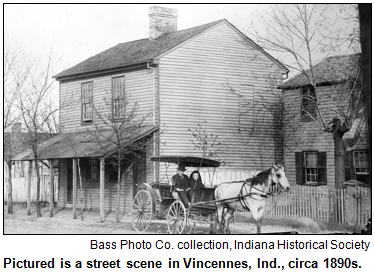 Indiana's oldest city already had a colorful history when ancestors of Lorene Burkhart arrived about 1800. That also was about when the frontier town of Vincennes, which had been founded by a French-Canadian fur trader in 1732, became the capital of the new Indiana Territory. From a girlhood on a family farm located on the high point between the Wabash and White rivers near Vincennes, Lorene went on to become one of the best-known civic leaders in Indianapolis.
Indiana's oldest city already had a colorful history when ancestors of Lorene Burkhart arrived about 1800. That also was about when the frontier town of Vincennes, which had been founded by a French-Canadian fur trader in 1732, became the capital of the new Indiana Territory. From a girlhood on a family farm located on the high point between the Wabash and White rivers near Vincennes, Lorene went on to become one of the best-known civic leaders in Indianapolis.
To share insights about her hometown and about her personal journey, which has included careers as a business executive and as a TV personality who shared home-oriented tips such as (to use her phrase) "an early Martha Stewart," Lorene will join Nelson in studio.
Her ancestors, the McCormicks, have been influential in the Vincennes area ever since George McCormick ran a blacksmith shop in the early 1800s. Lorene's father, Clarence McCormick (1902-1983), started out as an Indiana farm boy who initially traveled to high school by horse and buggy; he eventually became under secretary of agriculture President Harry Truman.
 As Lorene notes in her book An Accidental Pioneer: A Farm Girl's Drive to the Finish (Hawthorne Publishing), the town of Vincennes was laid out with a design that "in typical French fashion, starts from the river."
As Lorene notes in her book An Accidental Pioneer: A Farm Girl's Drive to the Finish (Hawthorne Publishing), the town of Vincennes was laid out with a design that "in typical French fashion, starts from the river."
Not only has the French flag flown over the town, so has the Union Jack. During the Revolutionary War, the British seized Vincennes and renamed it Fort Sackville. In a significant triumph for the fledgling Americans in 1779, frontier fighter George Rogers Clark and his ragtag troops liberated the town from the British by deceiving them into thinking their forces were much greater than in reality.
The massive George Rogers Clark Memorial in Vincennes was dedicated by President Franklin D. Roosevelt in 1936. The McCormicks attended the ceremony, with infant Lorene in tow.
Her family's farm was seven miles from town. Lorene writes that her chores included plucking feathers off chickens after her mother killed them, an image that may seem jarring to those who know her as an elegant philanthropist whose awards have included honorary doctorates from Purdue University (her alma mater) and the University of Indianapolis, where she has served on the board of trustees.
A former board member for organizations such as Girls Inc., Meals on Wheels and the Arts Council of Indianapolis, Lorene now lives in a penthouse apartment in Indy that has served as the setting for scores of fund-raisers and civic galas.
"At heart, she has remained a farm girl," according to the author's bio in An Accidental Pioneer. Her roots obviously run deep, both to the farm and to Knox County, where Vincennes is the hub. Consider some nuggets from her book:
 Her maternal grandfather, a dairy farmer, died in 1932 after being attacked by an angry bull.
Her maternal grandfather, a dairy farmer, died in 1932 after being attacked by an angry bull.- Lorene's grandmother was the first woman in Knox County to have a home sewing machine. According to An Accidental Pioneer, farm wives traveled for miles to see it.
- Her ancestors settled in Vincennes after traveling north from Kentucky by following a "buffalo trace." Lorene notes that a buffalo trace was "a wide path made by migrations of buffalo, with their heavy bodies and small feet."
Buffalo traces may have made for traditional paths to Vincennes in the beginning. The McCormick farm in the 1930s and '40s, though, was overseen in a non-traditional way. As Lorene's father took on increasingly significant roles in agricultural affairs, her mother ran the farm almost single-handedly.
Her parents' commuter marriage, highly unusual for the era, remained strong even when Clarence McCormick was based in Washington, D.C., after being appointed under secretary of agriculture in 1950. (He had been an original board member of the Indiana Farm Bureau in Indianapolis.)
Back in Vincennes, his appointment was huge news. Lorene was 16 years old; her social life, according to An Accidental Pioneer, focused primarily on 4-H activities. She planned to teach home economics.
Instead, Lorene became an executive with companies such as Jenn-Air and Borden Inc. In the 1970s, she offered tips as a home economist on Channel 13 in Indianapolis (during the era when David Letterman was the TV station's weatherman) and on various radio stations.
An Accidental Pioneer includes recipes, many for dishes served at family gatherings in Vincennes. Lorene's book also describes landmarks in her hometown, including the oldest Catholic church in the state. Built in 1826 and often referred to as the "Old Cathedral," the formal name of this historic church is the Basilica of St. Francis Xavier.
Some other nuggets:
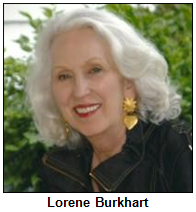 In recent years, Lorene has been an active volunteer at School 43 (James Whitcomb Riley School) in the Indianapolis Public Schools system.
In recent years, Lorene has been an active volunteer at School 43 (James Whitcomb Riley School) in the Indianapolis Public Schools system.- Her late husband, John Burkhart, was a prominent Indianapolis business leader. He founded College Life Insurance Co., built the distinctive-looking office complex known as "the Pyramids" on the northwest side of Indy and owned the Indianapolis Business Journal.
- Lorene will sign copies of An Accidental Pioneer during the Holiday Author Fair on Dec. 3. The event at the Eugene and Marilyn Glick Indiana History Center will feature more than 70 authors with Indiana connections, and Hoosier History Live!will be broadcast live from the author fair in our regular time slot.
History Mystery
William Henry Harrison was named the first governor of the Indiana Territory in 1800. Three years later, he began building a grand home in Vincennes for his large family. 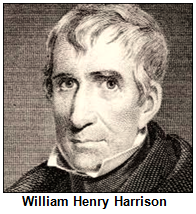 Harrison, who had grown up on a plantation in Virginia, modeled his Vincennes home after the mansion of his boyhood. His Federal-style mansion in Vincennes is thought to be the first brick house built in Indiana. The historic mansion, which has been preserved through the efforts of the DAR, is now a popular tour destination.
Harrison, who had grown up on a plantation in Virginia, modeled his Vincennes home after the mansion of his boyhood. His Federal-style mansion in Vincennes is thought to be the first brick house built in Indiana. The historic mansion, which has been preserved through the efforts of the DAR, is now a popular tour destination.
The mansion in Vincennes has a distinctive name.
Question: What is it?
To win the prize, you must call in with the correct answer during the live show. Please do not call if you have won a prize from any WICR show during the last two months. The call-in number is (317) 788-3314, and please do not call until you hear Nelson pose the question on the air.
The prize is two tickets from the Kurt Vonnegut Memorial Library to the documentary film The Cats of Mirikitani and director's discussion at the Athenaeum in downtown Indianapolis at 8 p.m. on Friday, Nov. 25.
Roadtrip: Portland Arch Nature Preserve near Covington
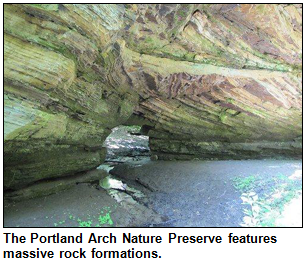 Our Roadtripper, Chris Gahl of the ICVA, suggests we take the Roadtrip to the Portland Arch Nature Preserve near Covington in western Indiana.
Our Roadtripper, Chris Gahl of the ICVA, suggests we take the Roadtrip to the Portland Arch Nature Preserve near Covington in western Indiana.
This Roadtrip is recommended by Glory-June Greiff, who says it's a great hike, and you'll find some massive rock formations that are rather surprising for Indiana.
Stop by nearby Williamsport and you will see, at the right time of the year, a huge waterfall that's right in the middle of "downtown" Williamsport!
Across the Wabash River is Attica, with its fabulous Art Deco movie theater, the Devon, and the historic 1850 Hotel Attica, which is very much open for business and also has a nice restaurant.
Your Hoosier History Live! team,
Nelson Price, host and creative director
Molly Head, producer, (317) 927-9101
Chris Gahl, Roadtripper
Richard Sullivan, webmaster and tech director
Pam Fraizer, graphic designer
Garry Chilluffo, creative consultant
Michele Goodrich, Jed Duvall, grant consultants
www.hoosierhistorylive.org


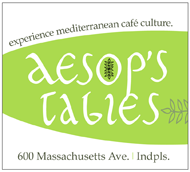


Please tell our sponsors that you appreciate their support: Aesop's Tables, Indiana Historical Society, Lucas Oil, Sexton Companies and Story Inn.
 Acknowledgments to Print Resources, Indianapolis Marion County Public Library, Monomedia, Indiana Humanities, Indianapolis Convention & Visitors Association, WICR-FM, Fraizer Designs, Heritage Photo and Research Services, Derrick Lowhorn, Samantha Stratton and many other individuals and organizations. We are an independently produced program and are self-supporting through organizational sponsorships, grants and through individual tax-deductible contributions through the Indiana Humanities Council. Visit our website to learn how you can support us financially.
Acknowledgments to Print Resources, Indianapolis Marion County Public Library, Monomedia, Indiana Humanities, Indianapolis Convention & Visitors Association, WICR-FM, Fraizer Designs, Heritage Photo and Research Services, Derrick Lowhorn, Samantha Stratton and many other individuals and organizations. We are an independently produced program and are self-supporting through organizational sponsorships, grants and through individual tax-deductible contributions through the Indiana Humanities Council. Visit our website to learn how you can support us financially.
A weekly thing
Hoosier History Live! listening group forms
 Did you hear it on the radio? Sue Kennedy, manager of the Irvington Branch of the Indianapolis Public Library at 5625 E. Washington St., has announced the formation of a weekly Coffee Chats listening group, beginning this Saturday, Nov. 19.
Did you hear it on the radio? Sue Kennedy, manager of the Irvington Branch of the Indianapolis Public Library at 5625 E. Washington St., has announced the formation of a weekly Coffee Chats listening group, beginning this Saturday, Nov. 19.
Just stop by the Story Theater at the Irvington Library at 11:30 a.m. to listen to the live show between 11:30 a.m. and noon, and then discuss afterward. The listening group is free and open to the public, and no reservation is required; just bring your cup o' java. Your facilitator this week will be Mike Hilton of the library's staff. More information at 275-4450.
Nov. 26 show
Tee Pee and other drive-ins, bygone or surviving
Among all of the hangouts that thrived across the country during the "cruising" craze of the 1950s, did any city have a drive-in more beloved than the Tee Pee Restaurant in Indianapolis?
Actually, the Hoosier capital spawned two Tee Pees. The first, which opened in the 1930s and initially was called the Wigwam, enjoyed a high-visibility site next to the Indiana State Fairgrounds on busy Fall Creek Parkway. Years later, a second Tee Pee opened on the Southside.
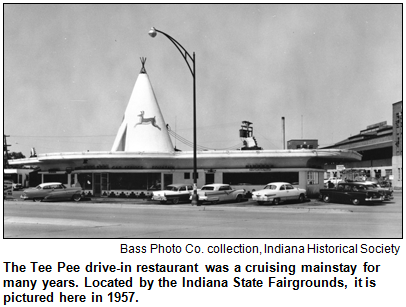 To explore the distinctive-looking Tee Pees and other Hoosier drive-ins, both those that are bygone and the smattering that remain, Nelson will be joined in studio by two guests with special connections to them.
To explore the distinctive-looking Tee Pees and other Hoosier drive-ins, both those that are bygone and the smattering that remain, Nelson will be joined in studio by two guests with special connections to them.
Public historian Glory-June Greiff spearheaded a much-publicized (but, alas, unsuccessful) crusade to save the Tee Pee from the wrecking ball in the 1980s. (Its site is now overflow parking for the fairgrounds.)
Retired WRTV-Channel 6 cameraman Dick Baldwin was one of the Tee Pee's most loyal customers, beginning in the 1950s.
Nelson, Glory and Dick won't confine their drive-in focus to the Tee Pees. Nelson will share insights about Knobby's Restaurants in Indy, popular drive-ins patronized by his family during the 1960s and '70s.
Glory, who grew up in northern Indiana, will dish about Bonnie Doon Drive-Ins of South Bend and Mishawaka. (Some Bonnie Doons - the source of Glory's fondness for choco-mint sodas - continue to thrive today.)
Although the Tee Pee was his fave, Dick also patronized the bygone Pole, a popular drive-in at Lafayette Road and West 16th Street in Indy. Nor will we forget the Ron-D-Vu near the Butler University campus, the North Pole at Illinois and 56th streets, and Al Green's Famous Food Drive-In on the Eastside.
Then there's Don Hall's Hollywood Drive-In in Fort Wayne, which also continues today; its promotions assure customers "the fabulous '50s will live on forever" there. Also going strong amid so many drive-in casualties are the Mug n Bun on the westside of Indy and The Suds Drive-In in Greenwood, which opened as the Dog n' Suds in 1957.
Park yourself at the radio and tune in as we savor the culture of cruising and the drive-ins that served as the epicenter.
© 2011 Hoosier History Live! All rights reserved.